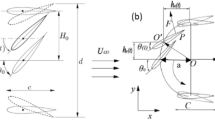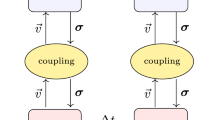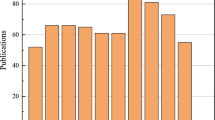Abstract
The periodically time-varying forces make the equilibrium state of Beihawk, an X-shaped flapping-wing aircraft, to be a periodic limit cycle oscillation. However, traditional controllers based on averaging theory fail to suppress this oscillation and the derived stability result may be inaccurate. In this study, a period-based method is proposed to design the oscillation suppression controller, locate the corresponding cycle and analyze its stability. A periodically time-varying wing-tail interaction model is built and Discrete Fourier Transform is applied to adapt the model for controller design. The harmonics less than quintuple flapping frequency account for more than 96 percent of the total harmonics and are reserved to present a concise model. Based on this model, active disturbance rejection controller (ADRC) is designed and its Extended State Observer can observe the disturbance to suppress the oscillation. Poincaré map is introduced to convert the stability analysis of the cycle to a fixed point. A multiple shooting method is adopted to locate several points on the cycle and the map is obtained by calculating the submaps between the adjacent points with the Floquet theory. The located points are proved to be accurate compared with the numerical solved cycle and the stability analysis result of the cycle is verified by the dynamic evolution. Compared with the State Feedback Controller, the ADRC performs better in suppressing the limit cycle oscillation and eliminating the attitude control error. The oscillation suppression is meaningful in maintaining a stable flight and capturing high quality images.


















Similar content being viewed by others
Data availability
All data used to support the findings of this study are available from the corresponding author upon request.
Code availability
This work is done using custom code.
References
Taha, H.E., Kiani, M., Hedrick, T.L., Greeter, J.S.M.: Vibrational control: a hidden stabilization mechanism in insect flight. Sci. Robot. 5, 1–12 (2020). https://doi.org/10.1126/SCIROBOTICS.ABB1502
Lee, J., Ryu, S., Kim, H.J.: Stable flight of a flapping-wing micro air vehicle under wind disturbance. IEEE Robot. Autom. Lett. 5, 5685–5692 (2020). https://doi.org/10.1109/LRA.2020.3009064
Warrick, D.R., Tobalske, B.W., Powers, D.R.: Aerodynamics of the hovering hummingbird. Nature 435, 1094–1097 (2005). https://doi.org/10.1038/nature03647
De Croon, G.C.H.E., Groen, M.A., De Wagter, C., Remes, B., Ruijsink, R., Van Oudheusden, B.W.: Design, aerodynamics and autonomy of the DelFly. Bioinspir. Biomimet. 7, 025003 (2012). https://doi.org/10.1088/1748-3182/7/2/025003
Wood, R., Nagpal, R., Wei, G.Y.: Flight of the robobees. Sci. Am. 308(3), 60–65 (2013)
Jiao, Z., Wang, L., Zhao, L., Jiang, W.: Hover flight control of X-shaped flapping wing aircraft considering wing–tail interactions. Aerosp. Sci. Technol. 116, 106870 (2021). https://doi.org/10.1016/j.ast.2021.106870
Sane, S.P.: The aerodynamics of insect flight. J. Exp. Biol. 206, 4191–4208 (2003). https://doi.org/10.1242/jeb.00663
Shyy, W., Berg, M., Ljungqvist, D.: Flapping and flexible wings for biological and micro air vehicles. Progr Aerosp Sci 35, 455–505 (1999)
Wang, Z.J.: Dissecting insect flight. Annu. Rev. Fluid Mech. 37, 183–210 (2005). https://doi.org/10.1146/annurev.fluid.36.050802.121940
Xuan, H., Hu, J., Yu, Y., Zhang, J.: Recent progress in aerodynamic modeling methods for flapping flight. AIP Adv. 10, 020701 (2020). https://doi.org/10.1063/1.5130900
Terze, Z., Pandža, V., Kasalo, M., Zlatar, D.: Optimized flapping wing dynamics via DMOC approach. Nonlinear Dyn. 103, 399–417 (2021). https://doi.org/10.1007/s11071-020-06119-y
Deng, X., Schenato, L., Sastry, S.S.: Flapping flight for biomimetic robotic insects: Part I—system modeling. IEEE Trans. Robot. 22, 776–788 (2006)
He, W., Yan, Z., Sun, C., Chen, Y.: Adaptive neural network control of a flapping Wing micro aerial vehicle with disturbance observer. IEEE Trans. Cybern. 47, 3452–3465 (2017). https://doi.org/10.1109/TCYB.2017.2720801
Maggia, M., Eisa, S.A., Taha, H.E.: On higher-order averaging of time-periodic systems: reconciliation of two averaging techniques. Nonlinear Dyn. 99, 813–836 (2020). https://doi.org/10.1007/s11071-019-05085-4
Deng, X., Schenato, L., Sastry, S.S.: Flapping flight for biomimetic robotic insects: Part II—flight control design. IEEE Trans. Robot. 22, 789–803 (2006). https://doi.org/10.1109/TRO.2006.875483
Cheng, B., Deng, X.: A neural adaptive controller in flapping flight. J. Robot. Mechatron. 24, 602–611 (2012). https://doi.org/10.20965/jrm.2012.p0602
Zhang, J., Tu, Z., Fei, F., Deng, X.: Geometric flight control of a hovering robotic hummingbird. In: Proc.—IEEE Int. Conf. Robot. Autom. 5415–5421 (2017). https://doi.org/10.1109/ICRA.2017.7989638
Fei, F., Tu, Z., Zhang, J., Deng, X.: Learning extreme hummingbird maneuvers on flapping wing robots. In: Proc.—IEEE Int. Conf. Robot. Autom. 2019-May, 109–115 (2019). https://doi.org/10.1109/ICRA.2019.8794100
Wissa, B.E., Elshafei, K.O., El-Badawy, A.A.: Lyapunov-based control and trajectory tracking of a 6-DOF flapping wing micro aerial vehicle. Nonlinear Dyn. 99, 2919–2938 (2020). https://doi.org/10.1007/s11071-020-05487-9
Chirarattananon, P., Ma, K.Y., Wood, R.J.: Adaptive control of a millimeter-scale flapping-wing robot. Bioinspir. Biomimet. 9, 025004 (2014). https://doi.org/10.1088/1748-3182/9/2/025004
Taha, H.E., Hajj, M.R., Nayfeh, A.H.: Flight dynamics and control of flapping-wing MAVs: a review. Nonlinear Dyn. 70, 907–939 (2012). https://doi.org/10.1007/s11071-012-0529-5
Hassan, A.M., Taha, H.E.: Combined averaging-shooting approach for the analysis of flapping flight dynamics. J. Guid. Control. Dyn. 41, 538–545 (2018). https://doi.org/10.2514/1.G002795
Taha, H.E., Hajj, M.R., Nayfeh, A.H.: Longitudinal flight dynamics of hovering MAVs/Insects. J. Guid. Control. Dyn. 37, 970–978 (2014). https://doi.org/10.2514/1.62323
Taha, H.E., Tahmasian, S., Woolsey, C.A., Nayfeh, A.H., Hajj, M.R.: The need for higher-order averaging in the stability analysis of hovering, flapping-wing flight. Bioinspir. Biomimet. 10, 016002 (2015). https://doi.org/10.1088/1748-3190/10/1/016002
Taha, H., Kiani, M., Navarro, J.: Experimental demonstration of the vibrational stabilization phenomenon in bio-inspired flying robots. IEEE Robot. Autom. Lett. 3, 643–647 (2018). https://doi.org/10.1109/LRA.2017.2778759
Taha, H.E., Woolsey, C.A., Hajj, M.R.: Geometric control approach to longitudinal stability of flapping flight. J. Guid. Control. Dyn. 39, 214–226 (2016). https://doi.org/10.2514/1.G001280
Taylor, G.K., Zbikowski, R.: Nonlinear time-periodic models of the longitudinal flight dynamics of desert locusts Schistocerca gregaria. J. R. Soc. Interfaces 2, 197–221 (2005). https://doi.org/10.1098/rsif.2005.0036
Nogar, S.M., Gogulapati, A., McNamara, J.J., Serrani, A., Oppenheimer, M.W., Doman, D.B.: Control-oriented modeling of coupled electromechanical-aeroelastic dynamics for flapping-wing vehicles. J. Guid. Control. Dyn. 40, 1664–1679 (2017). https://doi.org/10.2514/1.G002503
Biswal, S., Mignolet, M., Rodriguez, A.A.: Modeling and control of flapping wing micro aerial vehicles. Bioinspir. Biomimet. 14, 026004 (2019). https://doi.org/10.1088/1748-3190/aafc3c
Hassan, A.M., Taha, H.E.: Differential-geometric-control formulation of flapping flight multi-body dynamics. J. Nonlinear Sci. 29, 1379–1417 (2019). https://doi.org/10.1007/s00332-018-9520-8
Mouy, A., Rossi, A., Taha, H.E.: Coupled unsteady aero-flight dynamics of hovering insects/flapping micro air vehicles. J. Aircr. 54, 1738–1749 (2017). https://doi.org/10.2514/1.C034205
Su, W., Cesnik, C.E.S.: Flight dynamic stability of a flapping wing micro air vehicle in hover. Collect. Tech. Pap.—AIAA/ASME/ASCE/AHS/ASC Struct. Struct. Dyn. Mater. Conf. 1–17 (2011). https://doi.org/10.2514/6.2011-2009
Dietl, J.M., Garcia, E.: Stability in hovering ornithopter flight. Ind. Commer. Appl. Smart Struct. Technol. (2008). https://doi.org/10.1117/12.776482
Kamankesh, Z., Banazadeh, A.: Stability analysis for design improvement of bio-inspired flapping wings by energy method. Aerosp. Sci. Technol. 111, 106558 (2021). https://doi.org/10.1016/j.ast.2021.106558
Sane, S.P., Dickinson, M.H.: The aerodynamic effects of wing rotation and a revised quasi-steady model of flapping flight. J. Exp. Biol. 205, 1087–1096 (2002)
Banazadeh, A., Taymourtash, N.: Adaptive attitude and position control of an insect-like flapping wing air vehicle. Nonlinear Dyn. 85, 47–66 (2016). https://doi.org/10.1007/s11071-016-2666-8
Harmon, R.L.: Aerodynamic modelling of a flapping membrane wing using motion tracking experiments (2008)
Dickinson, M.H., Lehmann, F., Sane, S.P., Dickinson, M.H., Lehmann, F., Sane, S.P.: Wing rotation and the aerodynamic basis of insect flight. Science 80(284), 1954–1960 (1999)
Fung, Y.: An Introduction to the Theory of Aeroelasticity. Dover, New York (1969)
Sane, S.P., Dickinson, M.H.: Erratum: The control of flight force by a flapping wing: Lift and drag production (Journal of Expiremental Biology (2001) 204 (2607–2626)). J. Exp. Biol. 204, 3401 (2001)
Shkarayev, S., Moschetta, J.M., Bataille, B.: Aerodynamic design of micro air vehicles for vertical flight. J. Aircr. 45, 1715–1724 (2008). https://doi.org/10.2514/1.35573
Longfei, Z., Wenshuo, W., Yuxin, C., Zongxia, J.: Analytical modeling of a hoverable X-shape flapping wing aircraft considering wing-tail interaction. In: 32nd Congress of the international council of the aeronautical sciences, ICAS. pp. 1–11. , Shanghai, China (2021)
Anderson, J.D.: Fundamentals of Aerodynamics, Sixth Edition (2017)
Oppermann, R.H.: The elements of aerofoil and airscrew theory (1943)
Han, J.: From PID to active disturbance rejection control. IEEE Trans. Ind. Electron. 56, 900–906 (2009). https://doi.org/10.1109/TIE.2008.2011621
Madonski, R., Shao, S., Zhang, H., Gao, Z., Yang, J., Li, S.: General error-based active disturbance rejection control for swift industrial implementations. Control Eng. Pract. 84, 218–229 (2019). https://doi.org/10.1016/j.conengprac.2018.11.021
Wang, C., Chen, Z., Sun, Q., Qing, Z.: Design of PID and ADRC based quadrotor helicopter control system. Proc. 28th Chinese Control Decis. Conf. CCDC 2016. 5860–5865 (2016). https://doi.org/10.1109/CCDC.2016.7532046
Kuznetsov, Y.A.: Elements of Applied Bifurcation Theory, Second Edition. 614 (1998)
Amin, M.A., Hertzberg, M.P., Kaiser, D.I., Karouby, J.: Nonperturbative dynamics of reheating after inflation: a review. Int. J. Mod. Phys. D. 24, 1–46 (2015). https://doi.org/10.1142/S0218271815300037
Dednam, W., Botha, A.E.: Optimized shooting method for finding periodic orbits of nonlinear dynamical systems. Eng. Comput. 31, 749–762 (2015). https://doi.org/10.1007/s00366-014-0386-6
Dietl, J.M., Garcia, E.: Stability in ornithopter longitudinal flight dynamics. J. Guid. Control. Dyn. 31, 1157–1162 (2008). https://doi.org/10.2514/1.33561
Gao, Z.: Scaling and bandwidth-parameterization based controller tuning. Proc. Am. Control Conf. 6, 4989–4996 (2003). https://doi.org/10.1109/acc.2003.1242516
Acknowledgements
The authors acknowledge the financial support from the National Natural Science Foundation of China under Grants 51905014. The authors would also like to thank the editors and reviewers for their critical review of this manuscript.
Funding
The research is supported by Innovative Research Group Project of the National Natural Science Foundation of China Grant No. 51905014
Author information
Authors and Affiliations
Corresponding author
Ethics declarations
Conflict of interest
The authors declare that there is no conflict of interest regarding the publication of this paper.
Additional information
Publisher's Note
Springer Nature remains neutral with regard to jurisdictional claims in published maps and institutional affiliations.
Appendices
Appendix
Algorithm description of the LMA: Solving the located points on the circle.
Initialization
Indicative values for the user-defined parameters: \(\tau = 10^{ - 3} ,\varepsilon_{1} = \varepsilon_{2} = \varepsilon_{3} = 10^{ - 15} ,k_{\max } = 100\).
Input: A target error function \(g(\hat{x})\) and an initial state vector \( \hat{x}_{0} \in R^{(m + 1)n}\).
Output: A vector \( \hat{x}^{ + } \in R^{(m + 1)n}\) minimizing \(\chi^{2} (\hat{x})\).

Rights and permissions
About this article
Cite this article
Wang, L., Jiang, W., Jiao, Z. et al. Limit cycle oscillation suppression controller design and stability analysis of the periodically time-varying flapping flight dynamics in hover. Nonlinear Dyn 107, 3385–3405 (2022). https://doi.org/10.1007/s11071-021-07145-0
Received:
Accepted:
Published:
Issue Date:
DOI: https://doi.org/10.1007/s11071-021-07145-0




